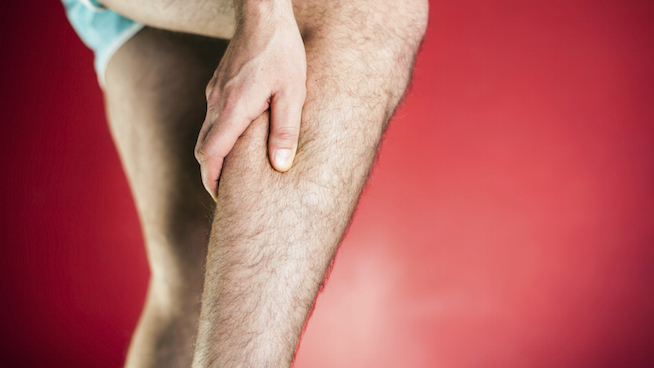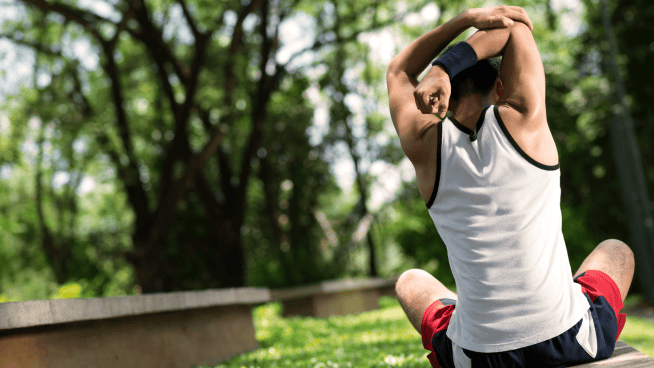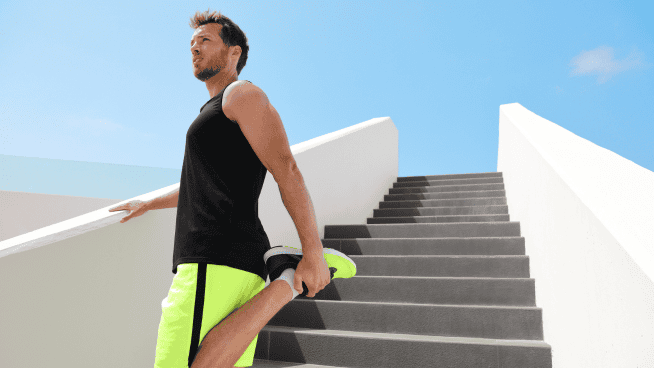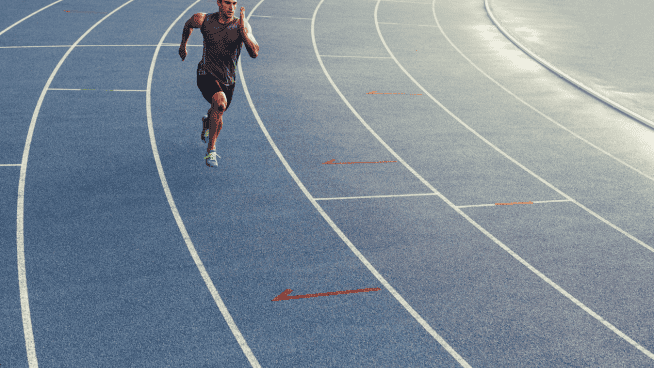3 Great Ways to Reduce Delayed Onset Muscle Soreness
![]()
The feeling is unmistakable. You take that first step out of bed the morning after a tough workout, and as soon as your foot hits the floor, a wave of pain rushes through your body. It’s called Delayed Onset Muscle Soreness (DOMS), and it’s often the price of glory after pushing your body to its physical limits.
We’ve all experienced DOMS and know it’s no fun. Can we make DOMS go away faster? Can we prevent it altogether?
What Is Delayed Onset Muscle Soreness?

DOMS is pain or discomfort that occurs as a result of muscle damage after strenuous exercise. It usually appears one to two days after the damage is done and can last for several days.
The severity of soreness depends on how much muscle damage occurred. Generally, greater soreness occurs with new movements (like when you start a new exercise routine) and eccentric muscle contractions (for example, the “lowering” portion of lifting exercises, landing from a jump or downhill running.)
Basically, when you exercise, you cause damage to muscle cell membranes, which creates inflammation and releases free radicals. Your body senses the damage and generates an inflammatory response, sending white blood cells and extra fluid to the damaged muscle cells. All this extra “stuff” causes swelling, leading to the pain, stiffness and weakness associated with DOMS.
Getting Rid of Delayed Onset Muscle Soreness
According to a 2003 review published in the Journal of Strength and Conditioning Research, there are three reliable ways to ease your aches and pains:
- Treat the muscle damage with massage or light exercise
- Treat the inflammation with pain medication, ice or compression
- Treat the free radicals with antioxidants and other nutritional supplements
These three plans of attack have varying levels of effectiveness. Let’s break them down according to what the research says.
RELATED: Beat Muscle Soreness with Ice and Heat
Treat the Muscle Damage

Exercise causes tiny tears in the muscle fibers, which take time to repair. In the meantime, we’re left with DOMS. Many recovery methods attempt to treat the muscle damage directly.
Stretching: According to a review, over 40 years of research has concluded that stretching, whether before or after exercise, does very little to help with soreness.
Massage: A 1994 study suggests that getting a massage two hours after exercise can reduce soreness by interrupting the body’s inflammatory process. A 2014 study on foam rolling found similar effects. Although this can make the pain go away, be aware that inflammation is a necessary part of healing, and disrupting inflammation prematurely may delay full recovery.
Electrical Stimulation: The use of e-stim units, such as those found in most athletic training rooms, has produced mixed results in relieving DOMS. A 2011 review concluded that although several types of e-stim devices increased bloodflow, which could theoretically speed up the healing process, they failed to reliably get rid of DOMS.
Treat the Inflammation
Excess inflammation can lead to the pain and swelling associated with DOMS. Some of the most researched anti-inflammatory methods include:
Non-Steroidal Anti-Inflammatory Drugs (NSAIDs): Over-the-counter NSAIDs, such as ibuprofen and naproxen, can reduce painful symptoms of DOMS after exercise. However, according to research, NSAIDs can delay muscle healing by disrupting the inflammatory process.
Cold Therapy: Many forms of cold therapy (ice packs, cold baths, etc.) have been studied for the purpose of enhancing muscle recovery. Despite its widespread use, icing has not been proven effective as an anti-inflammatory, according to a 2007 study. In fact, some research indicates cold therapy may even delay recovery from exercise.
Compression: A 2013 review found that wearing compression garments after exercise reduced perceived muscle pain, but saw smaller effects on recovery from sprinting and jumping performance.
RELATED: 6 Anti-Inflammatory Foods to Relieve Muscle Soreness
Treat the Free Radicals
Many people take nutritional supplements, specifically antioxidants, in hopes of recovering faster. Here are a few of the most researched supplements:
Vitamin C: A 1992 study found that taking 1 gram of Vitamin C per day three days before strenuous exercise and seven days post-exercise reduced soreness by up to 44 percent.
Vitamin E: Few studies have shown that taking Vitamin E can reduce DOMS, according to a 2003 report. This disputed findings from 1990 that suggested Vitamin E can reduce signs of muscle damage after exercise.
Branched Chain Amino Acids (BCAAs): A 2010 study found that supplementing with BCAAs prior to intense weight training significantly reduced soreness, possibly by limiting muscle damage.
What’s the Verdict?
Perhaps the most reliable method of relieving DOMS is a combination of massage (such as foam rolling), compression, proper nutrition and active recovery. That’s right—getting up and moving around is one of the simplest ways to rid yourself of DOMS without popping pain medicine or sitting in a tub of ice.
The next time you’re feeling roughed up from your workout, try these methods for a speedy recovery.
References:
- Adam, K. et al. “Sleep Helps Healing.” British Medical Journal 289.6456 (1984): 1400-401.
- Algafly, A. et al. “The Effect of Cryotherapy on Nerve Conduction Velocity, Pain Threshold and Pain Tolerance.” British Journal of Sports Medicine 41.6 (2007): 365-69.
- Avery, NG. et al. “Effects of Vitamin E Supplementation on Recovery From Repeated Bouts of Resistance Exercise.” Journal of Strength and Conditioning Research 17.4 (2003): 801-09.
- Basu, A. et al. “Dietary Factors That Promote or Retard Inflammation.” Arteriosclerosis, Thrombosis, and Vascular Biology 26.5 (2006): 995-1001.
- Bishop, S. et al. “The Effect Of Intermittent Arm And Shoulder Cooling On Baseball Pitching Velocity.” Journal of Strength and Conditioning Research E Pub Ahead of Print (2014).
- Born, DP. et al. “Bringing Light into the Dark: Effects of Compression Clothing on Performance and Recovery.” International Journal of Sports Physiology and Performance 8.1 (2013): 4-18.
- Cannon, JG. et al. “Acute Phase Response in Exercise: Interaction of Age and Vitamin E on Neutrophils and Muscle Enzyme Release.” American Journal of Physiology 259.6 (1990): 1214-219.
- Crowe, M. et al. “Cold Water Recovery Reduces Anaerobic Performance.” International Journal of Sports Medicine 28.12 (2007): 994-98.
- Guyton, A. et al. Textbook of Medical Physiology. Philadelphia: Saunders, 2000.
- Kaminski, M. et al. “An Effect of Ascorbic Acid on Delayed-onset Muscle Soreness.” Pain 50.3 (1992): 317-21.
- Kwon, Y. et al. “Effect of Local Cooling on Short-Term, Intense Exercise.” Journal of Strength and Conditioning Research 27.7 (2013): 2046-05.
- Sellwood, K. et al. “Ice-water Immersion and Delayed-onset Muscle Soreness: A Randomised Controlled Trial.” British Journal of Sports Medicine 41.6 (2007): 392-97.
- Tseng, C. et al. “Topical Cooling (Icing) Delays Recovery From Eccentric Exercise–Induced Muscle Damage.” Journal of Strength and Conditioning Research 27.5 (2013): 1354-361.
- Tseng, Ching-Yu, Jo-Ping Lee, Yung-Shen Tsai, Shin-Da Lee, Chung-Lan Kao, Te-Chih Liu, Cheng- Hsiu Lai, M. Brennan Harris, and Chia-Hua Kuo. “Topical Cooling (Icing) Delays Recovery From Eccentric Exercise-Induced Muscle Damage.” Journal of Strength and Conditioning Research 27.5 (2013): 1354-361. Print.
- Zainuddin, Z. et al. “Light Concentric Exercise Has a Temporarily Analgesic Effect on Delayed-onset Muscle Soreness, but No Effect on Recovery from Eccentric Exercise.” Applied Physiology, Nutrition, and Metabolism 31.2 (2006): 126-34.
RECOMMENDED FOR YOU
MOST POPULAR
3 Great Ways to Reduce Delayed Onset Muscle Soreness
![]()
The feeling is unmistakable. You take that first step out of bed the morning after a tough workout, and as soon as your foot hits the floor, a wave of pain rushes through your body. It’s called Delayed Onset Muscle Soreness (DOMS), and it’s often the price of glory after pushing your body to its physical limits.
We’ve all experienced DOMS and know it’s no fun. Can we make DOMS go away faster? Can we prevent it altogether?
What Is Delayed Onset Muscle Soreness?

DOMS is pain or discomfort that occurs as a result of muscle damage after strenuous exercise. It usually appears one to two days after the damage is done and can last for several days.
The severity of soreness depends on how much muscle damage occurred. Generally, greater soreness occurs with new movements (like when you start a new exercise routine) and eccentric muscle contractions (for example, the “lowering” portion of lifting exercises, landing from a jump or downhill running.)
Basically, when you exercise, you cause damage to muscle cell membranes, which creates inflammation and releases free radicals. Your body senses the damage and generates an inflammatory response, sending white blood cells and extra fluid to the damaged muscle cells. All this extra “stuff” causes swelling, leading to the pain, stiffness and weakness associated with DOMS.
Getting Rid of Delayed Onset Muscle Soreness
According to a 2003 review published in the Journal of Strength and Conditioning Research, there are three reliable ways to ease your aches and pains:
- Treat the muscle damage with massage or light exercise
- Treat the inflammation with pain medication, ice or compression
- Treat the free radicals with antioxidants and other nutritional supplements
These three plans of attack have varying levels of effectiveness. Let’s break them down according to what the research says.
RELATED: Beat Muscle Soreness with Ice and Heat
Treat the Muscle Damage

Exercise causes tiny tears in the muscle fibers, which take time to repair. In the meantime, we’re left with DOMS. Many recovery methods attempt to treat the muscle damage directly.
Stretching: According to a review, over 40 years of research has concluded that stretching, whether before or after exercise, does very little to help with soreness.
Massage: A 1994 study suggests that getting a massage two hours after exercise can reduce soreness by interrupting the body’s inflammatory process. A 2014 study on foam rolling found similar effects. Although this can make the pain go away, be aware that inflammation is a necessary part of healing, and disrupting inflammation prematurely may delay full recovery.
Electrical Stimulation: The use of e-stim units, such as those found in most athletic training rooms, has produced mixed results in relieving DOMS. A 2011 review concluded that although several types of e-stim devices increased bloodflow, which could theoretically speed up the healing process, they failed to reliably get rid of DOMS.
Treat the Inflammation
Excess inflammation can lead to the pain and swelling associated with DOMS. Some of the most researched anti-inflammatory methods include:
Non-Steroidal Anti-Inflammatory Drugs (NSAIDs): Over-the-counter NSAIDs, such as ibuprofen and naproxen, can reduce painful symptoms of DOMS after exercise. However, according to research, NSAIDs can delay muscle healing by disrupting the inflammatory process.
Cold Therapy: Many forms of cold therapy (ice packs, cold baths, etc.) have been studied for the purpose of enhancing muscle recovery. Despite its widespread use, icing has not been proven effective as an anti-inflammatory, according to a 2007 study. In fact, some research indicates cold therapy may even delay recovery from exercise.
Compression: A 2013 review found that wearing compression garments after exercise reduced perceived muscle pain, but saw smaller effects on recovery from sprinting and jumping performance.
RELATED: 6 Anti-Inflammatory Foods to Relieve Muscle Soreness
Treat the Free Radicals
Many people take nutritional supplements, specifically antioxidants, in hopes of recovering faster. Here are a few of the most researched supplements:
Vitamin C: A 1992 study found that taking 1 gram of Vitamin C per day three days before strenuous exercise and seven days post-exercise reduced soreness by up to 44 percent.
Vitamin E: Few studies have shown that taking Vitamin E can reduce DOMS, according to a 2003 report. This disputed findings from 1990 that suggested Vitamin E can reduce signs of muscle damage after exercise.
Branched Chain Amino Acids (BCAAs): A 2010 study found that supplementing with BCAAs prior to intense weight training significantly reduced soreness, possibly by limiting muscle damage.
What’s the Verdict?
Perhaps the most reliable method of relieving DOMS is a combination of massage (such as foam rolling), compression, proper nutrition and active recovery. That’s right—getting up and moving around is one of the simplest ways to rid yourself of DOMS without popping pain medicine or sitting in a tub of ice.
The next time you’re feeling roughed up from your workout, try these methods for a speedy recovery.
References:
- Adam, K. et al. “Sleep Helps Healing.” British Medical Journal 289.6456 (1984): 1400-401.
- Algafly, A. et al. “The Effect of Cryotherapy on Nerve Conduction Velocity, Pain Threshold and Pain Tolerance.” British Journal of Sports Medicine 41.6 (2007): 365-69.
- Avery, NG. et al. “Effects of Vitamin E Supplementation on Recovery From Repeated Bouts of Resistance Exercise.” Journal of Strength and Conditioning Research 17.4 (2003): 801-09.
- Basu, A. et al. “Dietary Factors That Promote or Retard Inflammation.” Arteriosclerosis, Thrombosis, and Vascular Biology 26.5 (2006): 995-1001.
- Bishop, S. et al. “The Effect Of Intermittent Arm And Shoulder Cooling On Baseball Pitching Velocity.” Journal of Strength and Conditioning Research E Pub Ahead of Print (2014).
- Born, DP. et al. “Bringing Light into the Dark: Effects of Compression Clothing on Performance and Recovery.” International Journal of Sports Physiology and Performance 8.1 (2013): 4-18.
- Cannon, JG. et al. “Acute Phase Response in Exercise: Interaction of Age and Vitamin E on Neutrophils and Muscle Enzyme Release.” American Journal of Physiology 259.6 (1990): 1214-219.
- Crowe, M. et al. “Cold Water Recovery Reduces Anaerobic Performance.” International Journal of Sports Medicine 28.12 (2007): 994-98.
- Guyton, A. et al. Textbook of Medical Physiology. Philadelphia: Saunders, 2000.
- Kaminski, M. et al. “An Effect of Ascorbic Acid on Delayed-onset Muscle Soreness.” Pain 50.3 (1992): 317-21.
- Kwon, Y. et al. “Effect of Local Cooling on Short-Term, Intense Exercise.” Journal of Strength and Conditioning Research 27.7 (2013): 2046-05.
- Sellwood, K. et al. “Ice-water Immersion and Delayed-onset Muscle Soreness: A Randomised Controlled Trial.” British Journal of Sports Medicine 41.6 (2007): 392-97.
- Tseng, C. et al. “Topical Cooling (Icing) Delays Recovery From Eccentric Exercise–Induced Muscle Damage.” Journal of Strength and Conditioning Research 27.5 (2013): 1354-361.
- Tseng, Ching-Yu, Jo-Ping Lee, Yung-Shen Tsai, Shin-Da Lee, Chung-Lan Kao, Te-Chih Liu, Cheng- Hsiu Lai, M. Brennan Harris, and Chia-Hua Kuo. “Topical Cooling (Icing) Delays Recovery From Eccentric Exercise-Induced Muscle Damage.” Journal of Strength and Conditioning Research 27.5 (2013): 1354-361. Print.
- Zainuddin, Z. et al. “Light Concentric Exercise Has a Temporarily Analgesic Effect on Delayed-onset Muscle Soreness, but No Effect on Recovery from Eccentric Exercise.” Applied Physiology, Nutrition, and Metabolism 31.2 (2006): 126-34.











